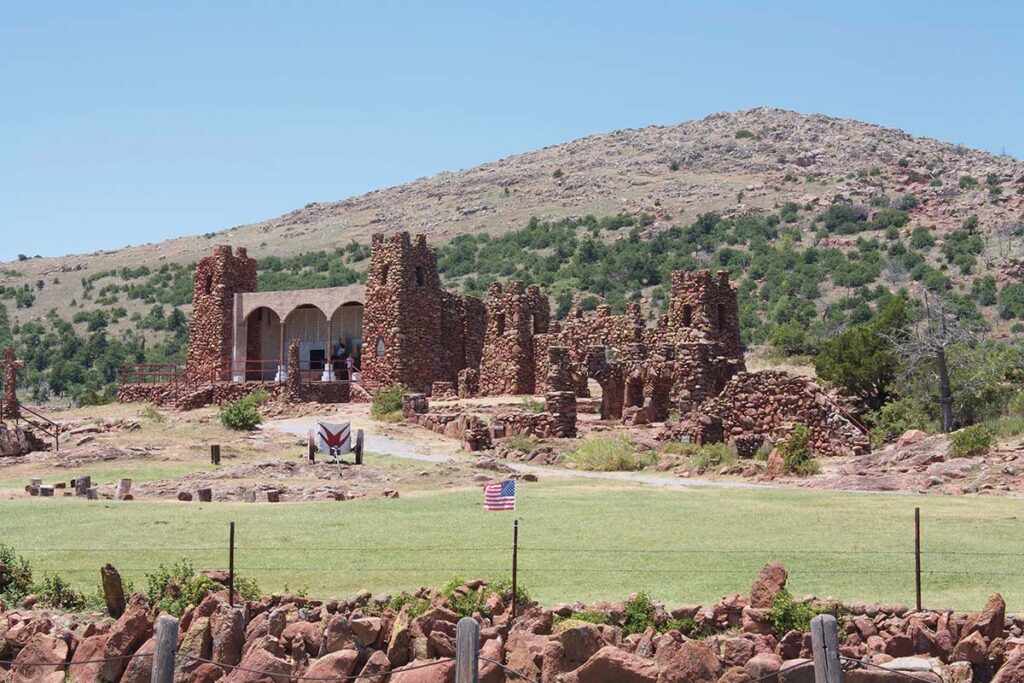I have lived in Oklahoma almost all my life but I have only been to the Lawton area once before a weekend trip this July.
The highlight of the trip was a car ride through the Wichita Mountains Wildlife Refuge.
Tulsa Beacon staff photo by Susan E. Biggs
The Wichita Mountains stand in stark contrast to the Oklahoma prairie.
We mostly stayed in our car because of the summer heat. In fact, the Refuge had posted restrictions due to the extreme summer heat (and drought). The heat plus the rugged, rocky landscape not only pose problems for visitors but are dangerous to emergency response personnel. This has led to a an Emergency Closure Order which is ongoing.
Hiking is only allowed from sunrise to 10 a.m. Hikers have to leave the trails and Mt. Scott Roadway before 10 a.m. After 10 a.m., the only hiking allowed is in established picnic areas and campgrounds. And all back-country camping in Charon’s Garden Wilderness Area is cancelled.
Tulsa Beacon staff photo by Susan E. Biggs
A sign in the Wichita Wildlife Refuge warns visitors of dangerous heat.
But there are no restrictions on cars and other motor vehicles plus biking. So we drove around the refuge.
It was odd to see mountains rise out of the prairie to form a backdrop for the Refuge, which contains about 60,000 acres of mixed grass prairie, granite mountains and beautiful, blue freshwater lakes.
We drove right among a herd of buffalo and we saw longhorn cattle. A friendly guide at the Visitor Center explained that a herd of longhorn cattle was settled in the refuge back when that breed was feared to become extinct.
The prairie dog village on the visitor map was deserted but we drove next a patch of prairie dogs who were poking their heads out of their holes to see what crazy tourists were driving by.
The Preserve has Rocky Mountain elk and whitetail deer but we didn’t see any. Around 275 species of birds nest in the Refuge. There are coyotes and cougars but we traveled in the hot afternoon and they were not to be found.
The visitor center is open from 9 a.m. to 5 p.m. daily.
The WMWR is not easy to get to. We drove down Interstate-44 and took Oklahoma 58 down south past Lake Lawtonka. What a gorgeous lake. The water is crystal clear and it has the backdrop of the mountains.
We took Oklahoma 277 to Meers, Oklahoma, because our kids told us that the Meers Restaurant (there’s only one in town) had one of the best hamburgers in Oklahoma. The beef is from longhorn steers who are culled from the refuse each year to manage the population.
The burgers were very good but they need to be because the restaurant, which sits on the side of hill, looks like it was built by the same guy who built the house on the old TV show, Green Acres. The restaurant’s aging interior is still being added on to.
The walls of the restaurant have photos of famous actors who filmed movies in the nearby mountains.
And due to staffing problems, the restaurant is only open Thursdays through Sundays.
Since we were so close, we took a drive to Medicine Park, Oklahoma, which is on the east edge of the refuge and just south of Lake Lawtonka. Medicine Park is a vintage cobblestone resort town. It has a population of 317 but a lot more during tourist season.
The exterior of most buildings is cobblestone, likely taken from the nearby mountain range. It is a tourist town but the people are very friendly and you can go swimming in the river that flows through the town. We didn’t because it was too hot.
The name of the town apparently came from Medicine Creek. The Kiowa and Comanche Tribes thought the water had medicinal value. Several famous people came to bathe there over the decades.
There are a few restaurants and souvenir shops.
Something else you wouldn’t expect to find in that part of the state is the Holy City of the Wichitas, famous for previously hosting an annual Easter Pageant that at one time drew as many as 100,000 visitors. It started in 1926. A movie, The Lawton Story, featured the Easter Pageant. In 1934-35, the Works Progress Administration built the present location, five miles west of the original. The campus still has the Temple Court, Pilate’s judgment hall, Calvary’s Mount, watch towers, rock shrines, the Lords Supper Building, Herod’s Court, a chapel and other structures. It is open to the public daily from 8 a.m. to 5 p.m.
The pageant never charged admission. Now, the 66-acre campus with 22 native granite buildings hosts weddings and the annual pageant. In 2019, it was added to the National Register of Historic Places.
The pageant shut down in 2020 due to the Chinese coronavirus but restarted in 2021.
This was not a short trip – about 200 miles – and your kids might get bored.
But this is well worth adding to the old bucket list.
